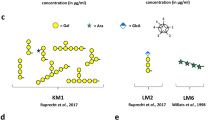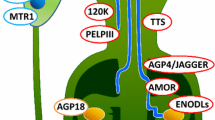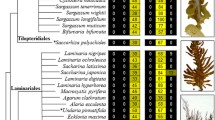Abstract
A biochemical investigation of arabinogalactan proteins (AGPs) in Physcomitrella patens was undertaken with particular emphasis on the glycan chains. Following homogenization and differential centrifugation of moss gametophytes, AGPs were obtained by Yariv phenylglycoside-induced precipitation from the soluble, microsomal membrane, and cell wall fractions. Crossed-electrophoresis indicated that each of these three AGP fractions was a mixture of several AGPs. The soluble AGP fraction was selected for further separation by anion-exchange and gel-permeation chromatography. The latter indicated molecular masses of ∼100 and 224 kDa for the two major soluble AGP subfractions. The AGPs in both of these subfractions contained the abundant (1,3,6)-linked galactopyranosyl residues, terminal arabinofuranosyl residues, and (1,4)-linked glucuronopyranosyl residues that are typical of many angiosperm AGPs. Unexpectedly, however, the moss AGP glycan chains contained about 15 mol% terminal 3-O-methyl-l-rhamnosyl residues, which have not been found in angiosperm AGPs. This unusual and relatively nonpolar sugar, also called l-acofriose, is likely to have considerable effects on the overall polarity of Physcomitrella AGPs. A review of the literature indicates that the capacity to synthesize polymers containing 3-O-methyl-l-rhamnosyl residues is present in a variety of bacteria, algae and lower land plants but became less common through evolution to the extent that this sugar has been found in only a few species of angiosperms where it occurs as a single residue on steroidal glycosides.








Similar content being viewed by others
Abbreviations
- AGP:
-
Arabinogalactan protein
- Ara:
-
Arabinose
- DMSO:
-
Dimethyl sulfoxide
- Fuc:
-
Fucose
- Gal:
-
Galactose
- Glc:
-
Glucose
- (β-d-Glc)3 :
-
β-glucosyl Yariv phenylglycoside
- GlcUA:
-
Glucuronic acid
- GLC-MS:
-
Gas–liquid chromatography-mass spectrometry
- Hyp:
-
Hydroxyproline
- Man:
-
Mannose
- Rha:
-
Rhamnose
- TMS:
-
Trimethylsilyl
- Xyl:
-
Xylose
References
Akiyama T, Tanaka K, Yamamoto S, Iseki S (1988) Blood-group active proteoglycan containing 3-O-methylrhamnose (acofriose) from young plants of Osmunda japonica. Carbohydr Res 178:320–326
Allard B, Casadevall E (1990) Carbohydrate composition and characterization of sugars from the green microalga Botryococcus braunii. Phytochemistry 29:1875–1878
Anderson DMW, Munro AC (1969) The presence of 3-O-methylrhamnose in Araucaria resinous exudates. Phytochemistry 8:633–634
Ashwell G (1966) New colorimetric methods of sugar analysis. Methods Enzymol 8:85–95
Basile DV, Basile MR (1988) Procedures used for the axenic culture and experimental treatment of bryophytes. In: Glime JM (eds) Methods in bryology. Proceedings of the bryological methods workshop, Mainz. Hattori Botanical Laboratory, Nichinan, Japan, pp 1–16
Basile DV, Basile MR, Mignone MM (2000) Arabinogalactan-proteins, place-dependent suppression and plant morphogenesis. In: Nothnagel EA, Bacic A, Clarke AE (eds) Cell and developmental biology of arabinogalactan-proteins. Kluwer /Plenum, New York, pp 169–178
Carpita NC, Gibeaut DM (1993) Structural models of primary cell walls in flowering plants: consistency of molecular structure with the physical properties of the walls during growth. Plant J 3:1–30
Carpita NC, Shea EM (1989) Linkage structure of carbohydrates by gas chromatography-mass spectrometry (GC-MS) of partially methylated alditol acetates. In: Biermann CJ, McGinnis GD (eds) Analysis of carbohydrates by GLC and MS. CRC, Boca Raton, pp 157–216
Ciucanu I, Kerek F (1984) A simple and rapid method for the permethylation of carbohydrates. Carbohydr Res 131:209–217
Doares SH, Albersheim P, Darvill AG (1991) An improved method for the preparation of standards for glycosyl-linkage analysis of complex carbohydrates. Carbohydr Res 210:311–317
Edelmann H, Neinhuis C, Jarvis MC, Evans B, Fisher E, Barthlott W (1998) Ultrastructure and chemistry of the cell wall of the moss Rhacocarpus purpurascens (Rhacocarpaceae): a puzzling architecture among plants. Planta 206:315–321
Fry SC (1988) The growing plant cell wall: chemical and metabolic analysis. Longman Scientific and Technical, Harlow, UK
Gaspar YM, Nam J, Schultz CJ, Lee L-Y, Gilson PR, Gelvin SB, Bacic A (2004) Characterization of the Arabidopsis lysine-rich arabinogalactan-protein AtAGP17 mutant (rat1) that results in a decreased efficiency of Agrobacterium transformation. Plant Physiol 135:2162–2171
Gerwig GJ, Kamerling JP, Vliegenthart JFG (1979) Determination of the absolute configuration of monosaccharides in complex carbohydrates by capillary GLC. Carbohdyr Res 77:1–7
Gorrod ARN, Jones JKN (1954) The hemicelluloses of Scots pine (Pinus sylvestis) and black spruce (Picea nigra) woods. J Chem Soc 2522–2525
Jackson LK, Slodki ME, Plattner RD, Burton KA, Cadmus MC (1982) Capsular and extracellular polysaccharides from Rhizobium microsymbionts of Acacia decurrens. Carbohydr Res 110:267–276
Kaplan M, Stephen AM, Vogt D (1966) 3-O-Methyl-L-rhamnose as a constituent of plant polysaccharide gums. S African Med J 40:702
Komalavilas P, Zhu JK, Nothnagel EA (1991) Arabinogalactan-proteins from the suspension culture medium and plasma membrane of rose cells. J Biol Chem 266:15956–15965
Kremer C, Pettolino F, Bacic A, Drinnan A (2004) Distribution of cell wall components in Sphagnum haline cells and in liverwort and hornwort elaters. Planta 219:1023–1035
Lee KJD, Sakata Y, Mau S-L, Pettolino F, Bacic A, Quatrano RS, Knight CD, Knox JP (2005) Arabinogalactan proteins are required for apical cell extension in the moss Physcomitrella patens. Plant Cell 17:3051–3065
Ligrone R, Vaughn KC, Renzaglia KS, Knox JP, Duckett JG (2002) Diversity in the distribution of polysaccharide and glycoprotein epitopes in the cell walls of bryophytes: new evidence for the multiple evolution of water-conducting cells. New Phytol 156:491–508
MacLennan AP (1962) The monosaccharide units in specific glycolipids of Mycobacterium avium. Biochem J 82:394–400
Matsunaga T, Ishii T, Matsumoto S, Higuchi M, Darvill A, Albersheim P, O’Neill MA (2004) Occurrence of the primary cell wall polysaccharide rhamnogalacturonan II in pteridophytes, lycophytes, and bryophytes. Implications for the evolution of vascular plants. Plant Physiol 134:339–351
Métraux J-P (1982) Changes in cell-wall polysaccharide composition of developing Nitella internodes: analysis of walls of single cells. Planta 155:459–466
Motose H, Sugiyama M, Fukuda H (2004) A proteoglycan mediates inductive interaction during plant vascular development. Nature 429:873–878
Muhr H, Hunger A, Reichstein T (1954) Die Glykosider der Samen von Acokanthera friesiorum Markgr. Glykoside und Aglykone. Helv Chim Acta 37:403–427
Nothnagel EA (1997) Proteoglycans and related components in plant cells. Int Rev Cytol 174:195–291
Ogawa K, Yamaura M, Maruyama I (1997) Isolation and identification of 2-O-methyl-L-rhamnose and 3-O-methyl-L-rhamnose as constituents of an acidic polysaccharide of Chlorella vulgaris. Biosci Biotechnol Biochem 61:539–540
Popper ZA, Fry SC (2003) Primary cell wall composition of bryophytes and charophytes. Ann Bot 91:1–12
Popper ZA, Fry SC (2004) Primary cell wall composition of pteridophytes and spermatocytes. New Phytol 164:165–174
Popper ZA, Sadler IH, Fry SC (2004) 3-O-Methylrhamnose in lower land plant primary cell walls. Biochem Syst Ecol 32:279–289
Qiu Y-L, Palmer JD (1999) Phylogeny of early land plants: insights from genes and genomes. Trends Plant Sci 4:6–30
Quatrano RS, McDaniel SF, Khandelwal A, Perroud P-F, Cove DJ (2007) Physcomitrella patens: mosses enter the genomic age. Curr Opin Plant Biol 10:182–189
Serpe MD, Nothnagel EA (1995) Fractionation and structural characterization of arabinogalactan-proteins from the cell wall of rose cells. Plant Physiol 109:1007–1016
Serpe MD, Nothnagel EA (1996) Heterogeneity of arabinogalactan-proteins on the plasma membrane of Rosa cells. Plant Physiol 112:1261–1271
Serpe MD, Nothnagel EA (1999) Arabinogalactan-proteins in the multiple domains of the plant cell surface. Adv Bot Res 30:207–289
Shaw J, Renzaglia K (2004) Phylogeny and diversification of bryophytes. Am J Bot 91:1557–1581
Shekharam KM, Venkataraman LV, Salimath PV (1987) Carbohydrate composition and characterization of two unusual sugars from the blue-green alga Spirulina platensis. Phytochemistry 26:2267–2269
Shibaya T, Kaneko Y, Sugawara Y (2005) Involvement of arabinogalactan proteins in protonema development from cultured cells of Marchantia polymorpha. Physiol Plant 124:504–514
Smith PK, Krohn RI, Hermanson GT, Mallia AK, Gartner FH, Provenzano MD, Fujimoto EK, Goeke NM, Olson BJ, Klenk DC (1985) Measurement of protein using bicinchoninic acid. Anal Biochem 150:76–85
Sun W, Kieliszewski MJ, Showalter AM (2004) Overexpression of tomato LeAGP-1 arabinogalactan-protein promotes lateral branching and hampers reproductive development. Plant J 40:870–881
Svetek J, Yadav MP, Nothnagel EA (1999) Presence of a glycosylphosphatidyl inositol lipid anchor on rose arabinogalactan proteins. J Biol Chem 274:14724–14733
Thomas RJ (1977) Wall analyses of Lophocolea seta cells (Bryophyta) before and after elongation. Plant Physiol 59:337–340
Tsai C-M, Frasch CE (1982) A sensitive silver stain for detecting lipopolysaccharides in polyacrylamide gels. Anal Biochem 119:115–119
Turvey JR, Griffiths LM (1973) Mucilage from a fresh-water red alga of the genus Batrachospermum. Phytochemistry 12:2901–2907
van Hengel AJ, Roberts K (2003) AtAGP30, an arabinogalactan-protein in the cell walls of the primary root plays a role in root regeneration and seed germination. Plant J 36:256–270
Vinogradov EV, Campos-Portuguez S, Yokota A, Mayer H (1994) The structure of the O-specific polysaccharide from Thiobacillus ferrooxidans IFO 14262. Carbohydr Res 261:103–109
Weckesser J, Katz A, Drews G, Mayer H, Fromme I (1974) Lipopolysaccharide containing L-acofriose in the filamentous blue-green algae Anabaena variabilis. J Bacteriol 120:672–678
Youl JJ, Bacic A, Oxley D (1998) Arabinogalactan proteins from Nicotiana alata and Pyrus communis contain glycosylphosphatidylinositol membrane anchors. Proc Natl Acad Sci USA 95:7921–7926
Acknowledgments
This work was supported by the Plant Biochemistry Program of the USDA National Research Initiative Competitive Grants Program (award no. 2002-35318-12616). Mention of trade names or commercial products in this article is solely for the purpose of providing specific information and does not imply recommendation or endorsement by the US Department of Agriculture.
Author information
Authors and Affiliations
Corresponding author
Rights and permissions
About this article
Cite this article
Fu, H., Yadav, M.P. & Nothnagel, E.A. Physcomitrella patens arabinogalactan proteins contain abundant terminal 3-O-methyl-l-rhamnosyl residues not found in angiosperms. Planta 226, 1511–1524 (2007). https://doi.org/10.1007/s00425-007-0587-y
Received:
Accepted:
Published:
Issue Date:
DOI: https://doi.org/10.1007/s00425-007-0587-y




